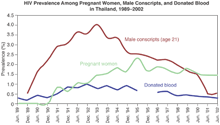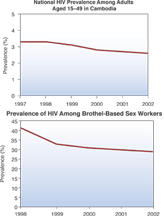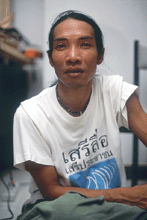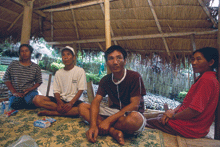
ASIA--THE NEXT FRONTIER FOR HIV/AIDS:
Two Hard-Hit Countries Offer Rare Success Stories: Thailand & Cambodia
Jon Cohen
By heavily promoting condom use, Cambodia and Thailand have blunted their epidemics, but the virus continues to make headway in some populations
CHIANG RAI AND BANGKOK, THAILAND, AND PHNOM PENH, CAMBODIA--On a moonless evening, a group of female and transgendered sex workers wearing identification cards around their necks strolls through a park that abuts a Buddhist temple in downtown Phnom Penh. The dark park has a wide variety of sex for hire. Men seeking men head for the fountain. Straight women sit on the grass with small piles of oranges in front of them, a thinly veiled cover for negotiating a later sexual rendezvous. Men dressed as women, some of whom have breasts from taking steroids, hang out near the restrooms. The people with the identification cards have worked this park themselves many a night, but this evening they have a different mission: Oxfam Hong Kong has hired them to distribute condoms.
Like neighboring Thailand, Cambodia has mounted a "100% condom program" that, with help from sex workers themselves, aims to persuade everyone selling or paying for sex to use a condom with each encounter. Supported by government and nongovernmental organizations, the campaigns have yielded measurable successes. In Cambodia, HIV prevalence among all adults fell from 4% in 1999 to 2.6% by the end of 2002, by which point the Ministry of Health estimated that a total of 259,000 Cambodians had become infected since the first case surfaced in 1991. A recent study by the Cambodian Ministry of Health projected that without increased condom use and other behavior changes, Cambodia would have had about three times as many HIV infections.

Grassroots prevention. A member of the Women's Network for Unity (in green) promotes condom use in a Phnom Penh park that has a flourishing sex trade.
PHOTO BY MALCOLM LINTON
Thailand, which recorded its first HIV case in 1984, by 1991 had already launched a nationwide 100% condom campaign. Although national figures do not exist for the early years of the epidemic, prevalence has stabilized at around 2%. "Most of the data confirm that prevalence declines after 1993, 1994," says Sombat Thanprasertsuk, who directs the Ministry of Public Health's AIDS branch. A recent model by his office similar to the Cambodian one suggests that if the country had not attempted to thwart HIV, 10% of the population would have become infected by 2000. "The condom program really worked," says Jordan Tappero, head of the large HIV/AIDS program in Thailand run by the U.S. Centers for Disease Control and Prevention (CDC). "It's very unusual that a woman in a brothel would accept a client without a condom."
Both the Thai and Cambodian programs have achieved even more impressive results among specific high-risk groups. "Consistent condom use" by Cambodia's brothel-based sex workers increased from 51.3% to 89.8% between 1998 and 2002, and HIV prevalence in that group plummeted from 42.6% to 28.8%. Another study conducted by Cambodia's national HIV/AIDS program shows that 75.8% of urban police reported having paid for sex in 1997, but that number had dropped to 32% by 2001.
In Thailand, that same population's prevalence dropped from 28.2% in 1996 to 12.27% in 2002. Timothy Mastro, Tappero's predecessor at CDC's Thailand program, says he well remembers the "tremendous excitement" when evidence first surfaced in 1995 that the prevalence in new military recruits had begun to drop in lockstep with increased condom use. "The Thai success was extremely heartening for everyone doing HIV prevention on a national level," says Mastro. "There really had not been a demonstration that a heterosexual epidemic could be changed by behavioral interventions and condom campaigns."


Turning the tide. Thailand's aggressive condom campaign receives much credit for dramatic drops in prevalence in military recruits (top). A model (bottom) shows how stabilizing the epidemic has likely averted millions of infections.
GRAPH SOURCE: THAILAND'S MINISTRY OF PUBLIC HEALTH
Today, leading AIDS epidemiologists routinely cite Cambodia and Thailand as examples of how aggressive prevention campaigns championed by enlightened governments can dramatically slow the spread of HIV. True enough. But the accolades tend to blur the fact that these two countries have extraordinarily different AIDS epidemics. And in spite of the successes, HIV, abetted by government policies that are far from progressive, continues to gain ground in some populations.
Thai troubles
At Saen Sok village in the lush mountains that surround the northern Thai city of Chiang Rai, four HIV-infected men and women from the Akha hill tribe sit at their chief's house under the shade of a sala, an open-air hut. Mingaw Huyi, who has one of her five children lying in her lap, became infected by her husband, a heroin addict who died from AIDS 3 years ago. The other three adults became infected because they shared needles themselves, and each has spent time in prison for heroin possession. One, Sompong Joebaw, 34, started injecting heroin 17 years ago, along with all of his closest friends. "I'm the only one left," he says. "They've all died from AIDS." Myat Htoo Razak, who heads a project for Family Health International that aims to lower the spread of HIV in the Akha, says that "hill tribes disproportionately have been affected by HIV/AIDS, and a lot of them have died already."
As the Akha see it, HIV continues to thrive in their community because of government discrimination. "There's an obvious prejudice against hill tribe people," says Micu Joebaw, 45, who says she began injecting more than 20 years ago and has lost one husband to AIDS, another to a bullet, and a son to suicide. Hill tribes speak their own languages, and many people here understand little Thai, which means that the bulk of HIV/AIDS education campaigns in Thailand have no impact on them. Many Akha--some of whom are refugees from Myanmar --do not have Thai citizenship, severely limiting their access to government services. Sompong had Thai papers, but they were revoked because of his drug use. They say the discrimination pervades the services that they do receive, too. Mingaw, who learned she was infected with HIV from a routine blood test during her last pregnancy, says the Thai nurses at the hospital where she gave birth publicly chided her for being infected. "I was very angry." Mingaw starts to cry. "But I couldn't say anything or it would get worse."

GRAPH SOURCE: CAMBODIA'S MINISTRY OF HEALTH
The chief, Teerawat Pitakpraisri, worries greatly about the future of his villagers. "In the past, drugs have been the number one problem," says Teerawat. "From now on, HIV will be the number one problem for their health, the burden to their family, and the community. The young especially will have no future and, in time, they'll get into this vicious circle."
HIV in injecting drug users (IDUs) among the Akha and other hill tribes represents a dramatic example of a problem that extends throughout Thailand. Since researchers started routinely assessing HIV infections at drug-treatment clinics in 1989, the HIV prevalence in IDUs of all ethnicities has remained steady at about 40%. A report issued by the World Bank in November 2000, Thailand's Response to AIDS: Building on Success, Confronting the Future, bluntly spelled out the situation. Written by World Bank economists Martha Ainsworth and Agnes Soucat in collaboration with epidemiologist Chris Beyrer of Johns Hopkins University's Bloomberg School of Public Health in Baltimore, Maryland, the report noted that "the pragmatic approach followed in preventing HIV transmission in commercial sex, which is also illegal, has not been followed for IDUs, who remain highly stigmatized, and frequently incarcerated."

IDUs fight back. Activist Paisan Tan-Ud advocates for drug users' rights.
PHOTO BY MALCOLM LINTON
Recently, 70 current and former IDUs formed an activist group, the Thai Drug Users Network. "Our message is 'Treat us like human beings; provide us with services like everyone else,' " says Paisan Tan-Ud, who helped organize the group. The network sharply criticizes the services that do exist. Methadone maintenance programs, it says, are restricted to Bangkok, and even those limit dosing to 45 days. "Methadone maintenance should give you methadone as long as you want it," contends Paisan. The clinics also taper doses, which he says leads many people to start using heroin again while receiving methadone. No needle-sharing programs exist, either, and regulations currently prohibit users of illegal drugs from receiving anti-HIV drugs. The World Bank report, which explored these shortcomings in detail, urged Thailand to launch "a major new effort" to prevent infection and transmission of HIV among IDUs. Otherwise, the report warned, "IDUs will continue to be a reservoir of infection and will pass HIV not only to other IDUs, but their sexual partners and children."
Sombat of the Ministry of Public Health's AIDS branch readily addresses the limitations to Thailand's success story. As for the hill tribes and discrimination, "we know there's a problem there," says Sombat, stressing that both the government and nongovernmental organizations are attempting to improve the situation. "We must do something fast, as quickly as possible." For IDUs, Sombat says he supports harm- reduction principles, which aim to treat addiction as a disease rather than a crime. "The behavior of sharing needles and equipment among IDUs is hard to change," says Sombat. And he acknowledges the shortcomings of their current treatment programs. "We know from the past that treatment for heroin users has a limited effect," he says. "The percent who are cured is quite low."
Cambodia's conundrum
Oddly, considering the plight of Cambodia's neighbors, injecting drug use has played no measurable role to date in the epidemic in Cambodia. No one has a convincing explanation for this--some suggest that poverty or the strict rule of the past kept drugs out of reach--but Hor Bun Leng, deputy director of the AIDS program run by Cambodia's Ministry of Health, worries that the situation might change. "You can see rising drug use here with smoking and sniffing, and that later could become injecting," he says. "And if we have IDUs, the outbreak will be more serious than ever before."
But there is another, immediate concern: HIV continues to spread through Cambodia's thriving sex industry, in spite of successful efforts to increase condom use. Rosanna Barbero, a coordinator for Oxfam Hong Kong, and many others note that the number of sex workers--and the spread of HIV-- exploded in 1993 when the United Nations sent more than 20,000 troops to the country to help restore order.

Hill tribe hardship. HIV-infected Akha say government discrimination fuels epidemic.
PHOTO BY MALCOLM LINTON
On a lazy Saturday morning in Phnom Penh, a group of sex workers who have gathered at the old Kong Kea Restaurant, a barge parked on the banks of the Tonle Sap River that serves as headquarters for Oxfam Hong Kong, highlights the stark limitations of condom campaigns and guffaws at the notion that the government has an enlightened position toward sex work. Indeed, frustrated by their government, sex workers formed the Women's Network for Unity 3 years ago, which has its office at the barge.
Although Cambodia, like Thailand, outlaws sex work, the government registers brothels and requires the women who work in them to visit clinics once a month for checkups to see whether they have any sexually transmitted diseases. But Barbero, who since 1999 has helped sex workers "empower" themselves, says that "ordinary people" do not like brothels. "Even men who regularly use brothels think it's against the culture," Barbero says.
The clash between Cambodia's cultural mores and the thriving sex work industry came to a head on 21 November 2001, when Prime Minister Hun Sen suddenly ordered all brothels shuttered. "It was very irresponsible for the prime minister to wake up one morning and say 'Close the brothels' without looking at the consequences," says Mu Soc Hua, minister for women's and veterans' affairs, who dressed up as a sex worker 2 days after the raids to see their effects firsthand. "The crackdown led girls onto the street, which led to more rape. And no one uses a condom during a rape, so it led to more spread of HIV. It also gave the police more freedom to raid brothels."
Hor Bun Leng readily acknowledges the government's murky policy toward sex workers but says that from the perspective of the Ministry of Health, the policymakers also deserve credit for helping slow the spread of HIV in this most vulnerable group. "Part of the success story is that the government allows us to work with high-risk populations," says Hor Bun Leng. "They open the door."
Hor Bun Leng stresses that residue from the country's politics of the past confronts him more profoundly than any current political obstacles. The Khmer Rouge-led genocide in the 1970s that killed nearly 2 million Cambodians--including his parents and siblings--left a severely impoverished population, and not just financially. "Because they survived this event, they have had limited information and education," he explains. This, in turn, makes it more difficult to compel them to change high-risk behaviors.
Hor Bun Leng says that in spite of the real decreases in prevalence and dramatic increases in the use of condoms, this is no time for Cambodia to drop its guard. "Cambodia looks like a patient who has recovered from a disease," he says, "but it's very easy to go back." Indeed, he adds: "We still have the highest prevalence of HIV in the world outside of Africa."
Volume 301,
Number 5640,
Issue of 19 Sep 2003,
pp. 1658-1662.
Copyright © 2003 by The American Association for the Advancement of Science. All rights reserved.
|